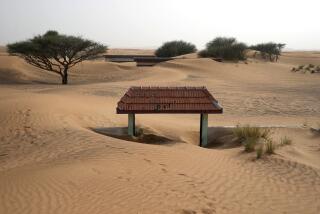Yemen’s Sands Offer Fertile Ground for Archeologists
- Share via
SAN'A, Yemen — The treasures of Yemen’s national museum are bathed in ruby, sapphire and emerald light shining through the building’s stained-glass windows, casting a kaleidoscopic glow on bronze statues of bygone kings and elegant pottery roughened by time.
The items on display are only the beginning. The scientific discovery of Yemen’s colorful past has barely begun. In both geographic and historic terms, vast areas of Yemen have been neglected because of the country’s long isolation and because scholars had turned their attention elsewhere.
“You don’t need to dig many years to get new information. Wherever you try, you find, because Yemen was densely populated in the past and there are archeological sites everywhere,” said Yusuf Abdullah, director of the country’s department of antiquities and museums.
American archeologist Christopher Edens looked at a map of Yemen, a country spread like a butterfly across the southern tip of Arabia. It is bordered to the north and east by Saudi Arabia and Oman and to the west and south by the Red Sea and the Gulf of Aden, with Africa just across the waters.
“Basically, it’s unknown,” said Edens, San’a director of the American Institute for Yemeni Studies. “We’re in a position to make sweeping discoveries--new things entirely. Even the basic, nitty-gritty questions, such as where and when things have happened, haven’t been answered.
“If you started a project anywhere in Yemen, the chances are that you’d make a significant discovery or advance of knowledge,” said Edens, who specializes in the Neolithic and Bronze ages.
Until very recently, scholars were speculating that Yemen didn’t have a human history during those periods. Most of the human souvenirs that had been discovered were from the later Iron Age, the time of the flourishing incense trade for which Yemen is famous.
But a 6-year-old University of Chicago project at Dhamar, 50 miles south of San’a, has unearthed evidence of villages and towns from the third millennium BC.
Dhamar was virtually untouched by researchers before 1994. But even areas that had been excavated in the past are yielding new discoveries now.
In 1998, Canadians and Germans began digging at Yemen’s most famous ancient site, a huge temple complex near Marib, about 100 miles east of San’a. The last major explorations had been done at Marib in the 1950s.
Marib is capital of the Saba dynasty, which ruled for centuries before Christ was born. Among the earliest mentions of a Sabaean ruler is the Biblical story of the visit by the Queen of Sheba, or Saba, to Solomon in the 10th century BC.
The late Wendell Phillips--to Yemeni archeology what Howard Carter of King Tutankhamen fame is to Egyptology--led the 1951-52 expedition to Marib under the auspices of the Virginia-based American Foundation for the Study of Man.
Some of the most intriguing pieces in the national museum come from Marib--gracefully modeled alabaster and marble bulls; altars; ceramic, stone and metal vessels. Inscriptions on stone tablets resemble Greek. The writing systems of ancient Yemen and Greece had a common source.
In just two years, the new excavations at Marib already have uncovered something new: paintings, an art form not previously associated with Saba.
“We know a lot about sculpture from south Arabia, but zip about paintings,” said Bill Glanzman, a University of Calgary archeologist who is among the leaders of the new dig at Marib.
Phillips’ early work and progress that Glanzman has made using modern technology--including radar and three-dimensional imaging--have given researchers details about how ancient Yemenis worshiped, Glanzman said. Inscriptions have been found, he said, with directives that appear to have been an attempt to rein in pilgrims who were swept away by devotion, making unsupervised sacrifices and building unauthorized monuments.
After recording 161 artifacts and 317 complete or fragmentary inscriptions from which much of what is known about the Sabaeans has been gleaned, Phillips and his staff had to flee for their lives. The local governor had become convinced they were hunting for gold and refusing to share with him.
In those days, researchers in Yemen could expect to meet “political isolation and turmoil fed by vicious rumor,” Glanzman said in telephone and e-mail interviews from Calgary. “And bear in mind that most of these villagers had never seen Westerners before.”
A dozen foreign teams have projects in Yemen now, according to Abdullah, the antiquities chief.
But Yemen has not completely overcome its past volatility. Tribesmen occasionally kidnap foreigners to demand money or public services from the Yemeni government. Archeologists today routinely head to their sites with armed escorts provided by the government--as do tourists to Marib, a region known as a kidnapping hotbed.
If the government is doing what it can to pull in the foreign researchers with the resources to undertake major excavations, other factors are pushing them here.
Scholars have long been more interested in places elsewhere in the region--Egypt with its Pharaonic monuments, Iraq and Syria with their Old Testament sites, Iran with its echoes of one of the world’s first great civilizations.
The result has been academic overcrowding, worsened in recent years by Iran and Iraq being cut off by politics. Yemen, always on the edge of the world in which scholars were interested, offers fresh ground.
Abdullah, an expert in the region’s ancient languages, said early texts refer again and again to the riches of Yemen and the longing of outsiders to see a country hidden and nearly inaccessible behind rugged mountains.
“There was always a zeal, an interest to come to this land, which was at the end of the Earth.”
More to Read
Sign up for Essential California
The most important California stories and recommendations in your inbox every morning.
You may occasionally receive promotional content from the Los Angeles Times.













